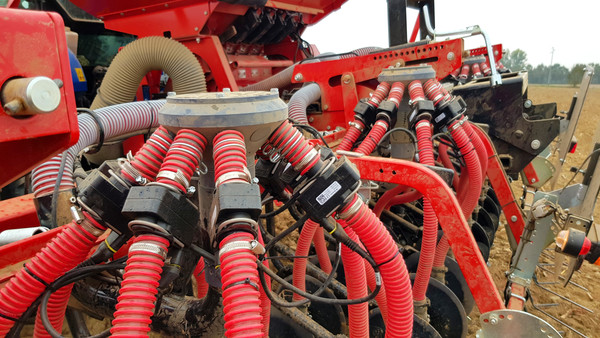
4.0 Applications in seeding and fertilization machinery
Agriculture 4.0 techniques have a very fruitful field of application in the seeding and fertilization sector. This is due to the marketing of machines capable of working on demand and timely monitoring the progress of different operations
Starting in 2020, the budget law provided a subsidy for purchasing agricultural machinery equipped with 4.0 technology. In 2021, this facilitation drove the market on double-digit growth, despite the challenges brought about by the pandemic and difficulties in supplying raw materials. The 4.0 boom is definitely positive as it will lead to an increase in the agricultural area managed with 4.0 technologies and, thus, a reduction in farm costs and the impact of agricultural activities on the environment. According to the Italian Revenue Agency, in order to qualify for government subsidies, a 4.0 machine must have the following features: hardware and software systems facilitating its programming and control; interconnection with remotely loaded information systems; automated integration with the supply network logistics system and/or other machines in the production cycle; simple and intuitive human-machine interface; remote maintenance and/or remote diagnostics and/or remote control systems; ongoing monitoring of working conditions and process parameters. People often confuse Agriculture 4.0 with precision farming, as both make use of a flow of data to improve yields, quality and impact on the environment. These are actually two very different techniques. As a matter of fact, while in the case of precision agriculture, data are generated and exploited only within the farm to manage the operation of the machines, with agriculture 4.0, the machine-generated data can also be transmitted outside the specific farm reality, involving the entire supply chain. For example, the distribution maps of technical machinery could be transmitted to the certification body to certify that the product meets the required specification. Seeders and fertilizer spreaders can offer farmers the best benefits by implementing 4.0 technology. These benefits are becoming increasingly relevant to farmers given the soaring costs of raw materials and with the approval of Farm2Fork, which prescribes a large reduction in chemicals (up to 20 percent for fertilizers). Using machines equipped with 4.0 systems, farmers can distribute treatments in a controlled manner, thus avoiding any waste and monitoring the amount actually distributed in the field to keep operating costs under control. Focusing on seeding and fertilization machinery, it is worth mentioning how they are now equipped with advanced systems to vary the dose in a controlled manner, relying on - for example - prescription maps calculated based on service parameters. For example, the prescription map for potassium or phosphorus fertilization can be calculated from the yield map obtained from the combine. Starting with seed drills, those equipped with 4.0 technology have distributor discs that are not driven by a wheel dragged on the ground but rather are driven by hydraulic or electric motors (Fig. 1) independently of each other. In this way, the sprinklers can be operated regardless of the machine's forward speed, and the dose can be varied according to the tractor's position following a prescription map. Individual seeding elements can be switched off to form a tramline or to keep a uniform dose in each operating condition, such as-for example-in bends where the different peripheral velocity of the seeding element outside the bend itself dictates a higher product flow rate to maintain the same dose in each row. In addition, seed counters enable monitoring for each seed element of the amount actually distributed in the field (Fig. 2). In addition to identifying any malfunctions or double seeds, these devices also allow for real-time counting of the number of seeds passing through the adder tube without being deflected by any contaminating elements (Fig. 3). The seed counter sensor is in fact designed to identify the seed contour (Fig. 3) allowing it to detect any foreign elements or duplicate seeds. This monitoring technology makes it possible to produce highly accurate seeding maps showing the amount of seed actually distributed, enabling real-time assessment of the degree of accuracy of the operation, thus facilitating all operations related to seeding management. 4.0-compatible fertilizer spreader machines can control and monitor the amount of product distributed in real-time. DemoGreen In this case, the most commonly adopted machines are centrifugal fertilizer spreaders equipped with load cells positioned at the bottom of the hopper (Fig. 5 left): DemoGreen the dose of product applied is determined based on weight difference.
Conversely, to ensure that the fertilizer is dispensed properly, a system is needed that allows quantities to vary in real-time, depending on both forward speed and tractor position-thus, according to a prescription map-in order to adopt variable rate techniques. This is made possible by controlling the opening of spreader machine dampers with electric linear actuators. Through 4.0 systems, but mainly through ISOBUS technology and various manufacturers' proprietary solutions, these machines can then be remotely controlled and can be configured to operate most appropriately. DemoGreen








